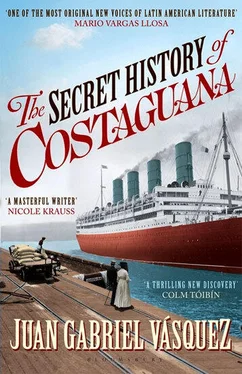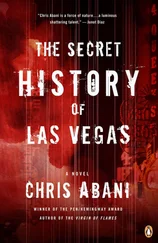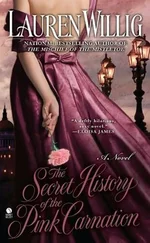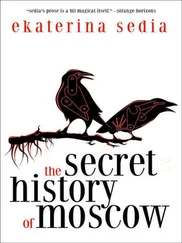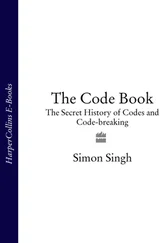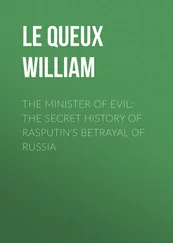My father was — as I have already said — the Last Renaissance Man. I cannot say he was of blue blood, because that hue was no longer acceptable in the new republic, but what flowed through his veins was magenta, shall we say, or maybe purple. His tutor, a frail and sickly man who had been educated in Madrid, educated my father in turn with the Quixote and Garcilaso; but the young Altamirano, who by the age of twelve was already a consummate rebel (as well as a terrible literary critic), strove to reject the literature of the Spaniards, the Voice of the Occupation, and in the end succeeded in doing so. He learned English to read Thomas Malory, and one of his first published poems, a hyperromantic and mawkish creation comparing Lord Byron to Simón Bolívar, appeared under the signature Lancelot of the Lake. My father discovered later that Byron had in fact wanted to come and fight with Bolívar, and it was only chance that finally took him to Greece; and what he henceforth felt for Romantics, from England and anywhere else, began to replace little by little the devotions and loyalties his elders had left him as his birthright.
Not that this was difficult, for by the age of twenty the Latin American Byron was already orphaned. His mother had been killed by smallpox; his father (in a much more elegant way) by Christianity. My grandfather, an illustrious colonel who had fought against the dragoons of many Spanish regiments, was stationed in the southern provinces when the progressive government decreed the closure of four convents, and saw the first riots in defense of religion at bayonet point. One of those Catholic, apostolic, and Roman bayonets, one of those steel points engaged on the crusade for the faith, stabbed him months later; the news of his death arrived in Bogotá at the same time as the city was preparing to repel an attack by those same Catholic revolutionaries. But Bogotá or Santa Fe was, like the rest of the country, divided, and my father would never forget it: leaning out of a window at the university, he saw the people of Santa Fe in procession carrying a figure of Christ dressed in a general’s uniform, heard the shouts of “Death to the Jews,” and marveled at the thought that they referred to his stabbed father, and then returned to the classroom routine, in time to observe his fellow students stabbing with sharp, pointed instruments cadavers recently arrived from the battlefields. For there was nothing at that time, absolutely nothing, the Latin American Byron liked more than being a first-hand witness to the fascinating advances of medical science.
He had enrolled in the Faculty of Law, in obedience to my grandfather’s wishes, but after a while devoted only the first part of his days to the legal codes. Like a Don Juan divided between two lovers, my father went from the ordeal of waking at five in the morning to listen to lectures on codified crimes and methods of acquiring dominion to the hidden or secret or parallel life he began after lunch. My father had purchased, for the exorbitant price of half a real , a hat with a doctor’s rosette, so as not to be detected by the university police, and each day, until five in the afternoon, he hid out in the Faculty of Medicine and spent hours watching young men like himself, young men of his age and no more intelligent, carry out bold explorations into unknown regions of the human body. My father wanted to see how his friend Ricardo Rueda was able to deliver single-handedly the twins clandestinely born to an Andalusian gypsy, as well as to operate on the appendix of the nephew of Don José Ignacio de Márquez, professor of Roman law. And while this went on, a few blocks from the university other procedures were being carried out that were not surgical but whose consequences were no less serious, for in the velvet-covered armchairs of a ministry sat two men with a quill pen signing the Mallarino-Bidlack Treaty. In accordance with article XXXV, the country that was now called New Granada granted to the United States the exclusive right of transit across the Isthmus of the province of Panama, and the United States undertook, among other things, to maintain strict neutrality in questions of internal politics. And here begins the disorder, here begins. .
But no.
Not yet.
I’ll reveal more on the subject in a few pages.
The Last Renaissance Man earned a law degree, he did, but I hasten to say that he never practiced: he was too busy with the absorbing vocation of Enlightenment and Progress. By the age of thirty he had not been linked to a single young lady, but his file as founder of Benthamist/revolutionary /socialist/Girondist newspapers expanded scandalously. There was no bishop he had not insulted; there was no respectable family who had not forbidden his entrance into their home or his courting of their daughters. (At La Merced College, a recently founded school for the most distinguished señoritas, his name was anathema.) Little by little my father specialized in the delicate art of earning disfavor and doors slammed in his face, and Santa Fe society joined willingly in the great slamming. My father did not worry: at that time the country he lived in had become unrecognizable — its borders had changed or were threatening to change, it had a different name, its political constitution was as mobile as a donna —and the government for which my grandfather had died had turned, for this reader of Lamartine and Saint-Simon, into the most reactionary of afflictions.
Enter Miguel Altamirano, activist, idealist, optimist; Miguel Altamirano, more than liberal, radical, anticlerical. During the elections of 1849, my father was one of those who purchased the material for the banners that hung all over Bogotá with the slogan VIVA LÓPEZ, TERROR OF THE CONSERVATIVES; he was one of those who gathered outside Congress to intimidate (successfully) the men who were going to elect a new president; once López, candidate of the young revolutionaries, was elected, he was one of those who demanded from the columns of the newspaper of the moment — I don’t remember which one it was at the time, whether The Martyr or The Struggle —the expulsion of the Jesuits. Reaction of the reactionary society: eighty little girls dressed in white with flowers in their hands assembled in front of the Palace to oppose the measure; in his newspaper, my father called them “Instruments of Obscurantism.” Two hundred ladies of unquestionable lineage repeated the demonstration, and my father distributed a pamphlet entitled Hell Hath No Fury Like a Jesuit Scorned . The priests of that New Granada, deprived of authority and privileges, hardened their positions as the months went by, and the sensation of harassment increased. My father, in response, joined the Estrella del Tequendama Masonic lodge: the secret meetings gave him a sense of conspiring (ergo of being alive), and the fact that the elders exempted him from the initiation trials made him think that Freemasonry was a sort of natural habitat. Through his efforts the temple managed to catechize two young priests; his patrons recognized these achievements with advanced promotions. And at some point in that brief process, my father, young soldier in search of battles, found one that appeared minor at first glance, almost trivial, but which would, albeit indirectly, change his life.
In September 1852, while it seemed to rain for forty days and forty nights all over New Granada, my father heard from an old friend from the Faculty of Medicine, liberal like him but less quarrelsome, of the Most Recent Outrage Against the God of Progress: Father Eustorgio Valenzuela, who had declared himself the spiritual guardian of the University of Bogotá, had unofficially banned the use of human cadavers for pedagogical, anatomical, and academic purposes. Surgical apprentices could practice on frogs or mice or rabbits, said the priest, but the human body, creation of divine hand and will, sacred receptacle of the soul, was inviolable and should be respected.
Читать дальше
